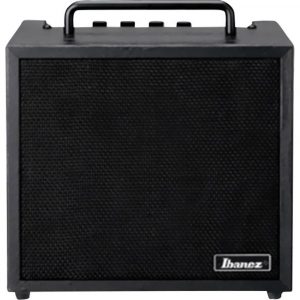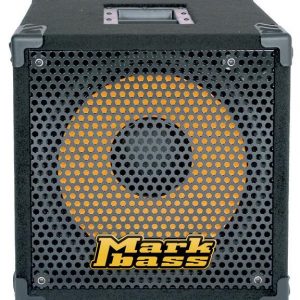Fender Rumble 200 V3
$387.99
Get ready to rock the stage with the powerful Fender Rumble 200 V3 bass amp that delivers massive sound and rich tone!
Compare
Description
The Fender Rumble 200 V3 bass amp is one of the latest offerings from the iconic guitar and bass amplifier manufacturer. This amp is the perfect solution for bass players who want a powerful, yet portable and versatile amp for practice and gigs.
The Rumble 200 V3 features a solid-state pre-amp and a 200-watt class D power amp. The combination of these two elements gives the Rumble 200 V3 a great sound that easily fills the room with its deep lows and crisp highs. The amp also boasts a range of EQ and tone shaping controls, allowing players to achieve the perfect sound for their playing style.
One of the standout features of the Rumble 200 V3 is its lightweight enclosure. Weighing in at just 34 pounds, this amp is easy to transport to and from gigs, rehearsals, and recording sessions. Despite its small size, the Rumble 200 V3 packs a big punch, delivering enough power to keep up with drums, guitar amps, and vocalists.
The Rumble 200 V3 also includes several different input and output options, making it a versatile tool for both live and studio settings. The amp features both XLR and 1/4 outputs, making it easy to connect to a sound system or recording device. Additionally, the amp can be used with an external speaker cabinet, providing even more volume and tonal possibilities.
Overall, the Fender Rumble 200 V3 bass amp is a fantastic choice for any bass player who wants a powerful and portable amp that sounds great in any setting. With its lightweight design, versatile tone shaping features, and range of input and output options, this amp is sure to please both beginners and experienced bassists alike.
Fender Rumble 200 V3 properties
| Product name |
Rumble 200 V3 |
| Brand |
Fender |
| Type |
Bass Amplifiers |
| Sound Setting |
Gain/Drive, Middle, Treble |
| Power Output (RMS) |
200.0 W |
| Amplifier Model |
Hybrid Combo |
| Colour |
Black |
| Impedance |
4 |
| Height |
701.0 mm |
| Depth |
455.0 mm |
| Width |
579.0 mm |
Frequently Asked Questions:
How does the Fender Rumble 200 V3 bass amplifier differ from its previous versions in terms of power output and connectivity options?
The Fender Rumble 200 V3 bass amplifier stands out from its predecessors, the Rumble 200 V1 and V2, in two significant ways. Firstly, it boasts a higher power output of 200 watts, which is a 50-watt increase over the V2 model. This makes it more than capable of delivering loud, clear sound even in large venues or rehearsal spaces. Secondly, the V3 model offers expanded connectivity options, including an XLR output with ground lift for connecting directly to a mixing console, as well as a USB/audio input for playing backing tracks or practicing with apps on your computer or tablet. Overall, these upgrades make the Fender Rumble 200 V3 an even more versatile and powerful choice for bass players looking for a top-performing amplifier.
"What specific features set the Fender Rumble 200 V3 apart from previous versions and how do they enhance the overall performance of this Bass Amplifier?"
The Fender Rumble 200 V3 Bass Amplifier stands out from its predecessors with a number of innovative features. Firstly, it boasts an improved EQ section with separate controls for bass, mid, and treble frequencies. This allows for greater precision in shaping the tone of your bass, making it easier to achieve your desired sound. Another notable feature is the new Active Feedback Reduction circuitry, which helps to eliminate unwanted low-frequency feedback at high volumes. This ensures that the overall sound quality remains clear and crisp, even in loud environments. Additionally, the Rumble 200 V3 has a new USB port for recording and playback directly from the amplifier, as well as an auxiliary input for connecting external audio sources such as MP3 players or laptops. This makes it a versatile tool for practicing, jamming, and even live performances. Overall, these features work together to enhance the overall performance of the Fender Rumble 200 V3 Bass Amplifier, delivering improved sound quality, greater tonal flexibility, and increased functionality in a sleek and compact design.
How does the proprietary Flex-Amp technology in the Fender Rumble 200 V3 bass amplifier provide versatile tone shaping capabilities?
The Fender Rumble 200 V3 bass amplifier is equipped with a unique technology called Flex-Amp. This proprietary feature offers versatile tone shaping capabilities by allowing the user to select from four different voicings, each simulating the response and character of classic Fender amps such as the Jazz Bass®, Precision Bass®, and Vintage Bass™. Additionally, a built-in compressor, EQ controls, and XLR output with adjustable level make it easy to dial in your preferred sound. Overall, this innovative technology provides bassists with a wide range of tonal options, from punchy and aggressive to warm and vintage-inspired.
How does the newly added USB/SD Card Reader on the Fender Rumble 200 V3 model enhance its versatility and functionality as a Bass Amplifier?
The newly added USB/SD Card Reader on the Fender Rumble 200 V3 amplifier significantly enhances its versatility and functionality by allowing bassists to connect external devices such as MP3 players, computers, or storage cards directly to the amp. This feature enables users to play along with backing tracks, stream music wirelessly, or load customized presets onto the amp's memory banks without the need for an intermediary device. Overall, it adds greater flexibility and convenience to the Rumble 200 V3, making it a more versatile and practical choice for bass players looking for a feature-packed amplifier.
What are the differences between the active and passive speaker outputs on the Fender Rumble 200 V3, and how do they affect the overall tone and headroom of the amplifier?
**Tonal Differences:**
* Active Output (XLR): When you use the active output, the amp is essentially sending a clean, uncolored signal directly to your mixing console or recording interface. This means that any EQ or processing you do on the console will be applied directly to the sound. In terms of tone, the active output tends to produce a more "transparent" and "neutral" sound, with less emphasis on midrange frequencies. Passive Output (1/4-inch phone jack): When you use the passive output, the amp is sending an unbalanced, high-impedance signal directly to your speaker cabinet. This means that any EQ or processing you do on the console will be affected by the tone-shaping characteristics of the amp itself. In terms of tone, the passive output tends to produce a more "warm" and "full-bodied" sound, with more emphasis on midrange frequencies. Headroom Differences:**
* Active Output (XLR): The active output has a lower impedance than the passive output, which means it can drive longer cable runs without significant signal loss. Additionally, the XLR output is balanced, which reduces hum and noise pickup from external sources. In terms of headroom, the active output tends to have more "headroom" or dynamic range, meaning it can handle higher signal levels before distorting. Passive Output (1/4-inch phone jack): The passive output has a higher impedance than the active output, which means it's less suitable for long cable runs. Additionally, the unbalanced nature of this output makes it more susceptible to hum and noise pickup from external sources. In terms of headroom, the passive output tends to have less "headroom" or dynamic range, meaning it can handle lower signal levels before distorting. When to Use Each Output:**
* Active Output (XLR): Use the active output when you need a clean, uncolored signal for recording or live mixing. This is ideal for applications where you want to apply EQ and processing on the console. Passive Output (1/4-inch phone jack): Use the passive output when you prefer a warmer, more full-bodied sound. This is ideal for applications where you're playing through a speaker cabinet in a small venue or rehearsal space. In summary, the active and passive speaker outputs on the Fender Rumble 200 V3 offer distinct tonal characteristics and headroom differences that can impact your overall tone and performance. By understanding these differences, you can choose the right output for your specific application and get the best possible sound from your amp.
Before you buy Fender Rumble 200 V3







Israel Waller –
Gain/Drive. Oh boy, this is where things get insane. I mean, who needs subtlety when you can have 4 stages of Gain and Drive? It’s like Fender took all the excess energy from a Carlsbad spring break party and funneled it into this amplifier.
Let me break it down for you: Stage 1, Clean, is where the magic happens. You get that perfect balance of punchy lows and crisp highs. But then, things take a turn for the wild, and you hit Stage 2, Slightly Dirty. This is where the Gain starts to creep in, and your bass notes begin to sound like they’re being played by a herd of elephants on steroids.
Stage 3, Overdrive, is where things get really interesting. The Drive kicks in, and it’s like someone poured a bottle of hot sauce directly into your speaker. It’s spicy, it’s loud, and it’ll leave you breathless (or at least, that’s what I imagine).
And finally, Stage 4, Fuzz, is the cherry on top or should I say, the splat of blood on the wall? This is where things get truly bonkers. It’s like Fender decided to take all the leftover Gain and Drive from the previous stages and mashed it into a pulp. The result? A sound so distorted, it’ll make you question your life choices.
But hey, that’s what makes the Fender Rumble 200 V3 so unique, folks! It’s like having a little piece of Carlsbad chaos in your music room, minus the risk of getting shot by a deranged student (RIP).
In all seriousness, though, this amplifier is a beast. With its unique sound settings and rugged design, it’s perfect for anyone looking to add some serious punch to their bass line just don’t try to play it during a school shooting, okay?